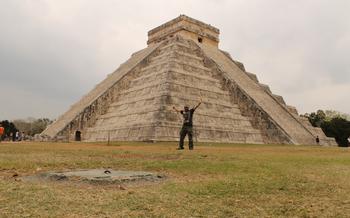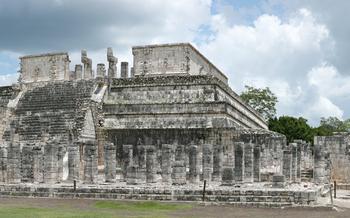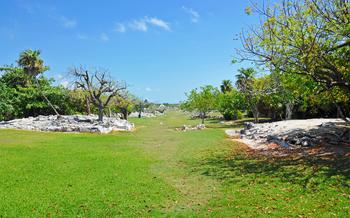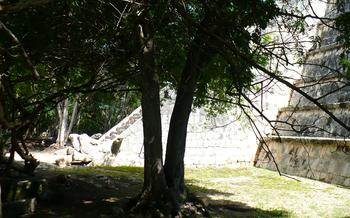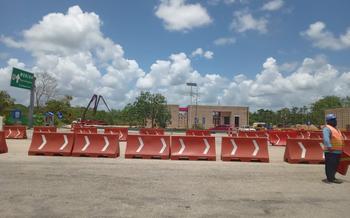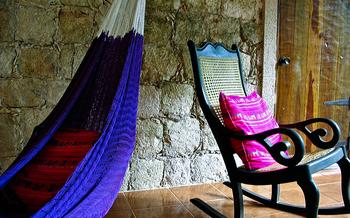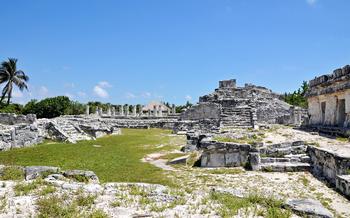
El Castillo (Temple of Kukulcan)
- A Journey to the Past: Unveiling Chichen Itza's History
- The Majesty of El Castillo: A Symbol of Architectural Prowess
- Ascending the Temple of Kukulcan: A Mesmerizing Experience
- Discovering the Secrets of the Temple's Interior
- Exploring the Northern Platform: A Realm of Sacred Structures
- Delving into the Mystery of the Cenote Sagrado: A Sacred Well
- Observing the Astronomical Phenomena at El Caracol: A Timeless Observatory
- Witnessing the Ancient Game of Pok-ta-Pok: The Great Ball Court
- Unraveling the Tales of the Temple of the Warriors: A Majestic Complex
- Admiration the Sculptures and Reliefs: A Testament to Maya Artistry
- Discovering the Temple of the Skulls: A Place of Ritual Sacrifice
- Discovering the Museum of Chichen Itza: A Treasure Trove of Artifacts
- Embarking on a Guided Tour: Unveiling Hidden Stories
- Capturing the Beauty of Chichen Itza: Photography Tips
- Insider Tip: Beyond the Crowds
A Journey to the Past: Unveiling Chichen Itza's History
Chichen Itza, a sprawling ancient city nestled in the heart of the Yucatan Peninsula, stands as a testament to the ingenuity and cultural prowess of the Maya civilization. This once-great metropolis, shrouded in mystery and wonder, played a pivotal role in shaping the history and legacy of the Maya people. Its architectural marvels, intricate carvings, and celestial alignments speak volumes about the advanced knowledge and sophisticated belief systems that governed their lives.
The city's origins can be traced back to the 6th century AD when it emerged as a prominent center of commerce and religious significance. Under the rule of the Maya ruler K'inich Janaab' Pakal, Chichen Itza flourished, becoming a powerful political and cultural force in the region. The city's influence extended far beyond its borders, as it forged alliances and engaged in trade with neighboring Maya city-states.
In the 10th century AD, Chichen Itza underwent a dramatic transformation when the Toltecs, a powerful warrior culture from central Mexico, arrived and conquered the city. The fusion of Maya and Toltec cultures gave rise to a unique blend of architectural styles and iconography, which can be seen throughout the city's many structures.
The decline of Chichen Itza began in the 13th century AD, coinciding with a period of drought and political upheaval. The city was eventually abandoned and left to the mercy of the jungle, where it lay hidden for centuries. In the 19th century, explorers and archaeologists rediscovered the ruins of Chichen Itza, sparking a renewed interest in Maya history and culture.
Today, Chichen Itza stands as a UNESCO World Heritage Site, attracting millions of visitors each year who come to marvel at its architectural wonders and immerse themselves in the rich history of the Maya civilization.
The Majesty of El Castillo: A Symbol of Architectural Prowess
El Castillo, also known as the Temple of Kukulcan, stands as the most iconic and awe-inspiring structure within the ancient city of Chichen Itza. Towering over the surrounding landscape, this colossal pyramid embodies the architectural genius and astronomical prowess of the Maya civilization.
Constructed from massive blocks of limestone, El Castillo showcases a remarkable combination of precision and artistry. Its square base measures an impressive 55 meters per side, rising to a height of approximately 30 meters. The pyramid's four sides are adorned with steep staircases, each consisting of 91 steps, culminating in a total of 365 steps—a symbolic representation of the solar year.
Intricate carvings and sculptures adorn the facade of El Castillo, depicting a myriad of mythological figures, celestial bodies, and historical events. These carvings provide valuable insights into Maya cosmology, religion, and their profound understanding of the cosmos.
The positioning of El Castillo is not merely coincidental but holds profound astronomical significance. The pyramid's alignment with the cardinal points and its precise angles allow for the creation of unique light and shadow effects during the spring and fall equinoxes. During these celestial events, the setting sun casts a serpent-like shadow that slithers down the northern staircase, creating the illusion of a feathered serpent descending from the heavens—a symbolic representation of the Maya deity Kukulcan.
El Castillo stands as a testament to the Maya civilization's architectural prowess, their profound understanding of astronomy, and their deep-rooted connection to the divine.
Ascending the Temple of Kukulcan: A Mesmerizing Experience
Venturing up the ancient steps of El Castillo is a thrilling experience that rewards visitors with breathtaking views and a sense of awe. The climb requires physical effort, but the challenge is well worth the reward. As you ascend, the pyramid's grandeur becomes increasingly apparent, and the surrounding landscape unfolds before your eyes.
The steps are steep and uneven, requiring careful footing, but the sturdy handrails provide support. The climb is not technically difficult, but it can be strenuous, especially in the heat. It's important to pace yourself and take breaks as needed. The journey to the top takes approximately 15-20 minutes, depending on your fitness level.
Upon reaching the summit, you'll be greeted by a breathtaking panorama. The lush jungle canopy stretches out in all directions, and the ruins of Chichen Itza are laid out before you like a giant jigsaw puzzle. The Great Ball Court, the Temple of the Warriors, and the Cenote Sagrado are all visible from this vantage point. The views are simply unforgettable.
Standing atop El Castillo, you can't help but feel a sense of awe at the architectural prowess of the Maya people. This pyramid is a testament to their ingenuity, their knowledge of astronomy, and their deep connection to the divine. It's an experience that will stay with you long after you've left Chichen Itza.
Discovering the Secrets of the Temple's Interior
Within El Castillo lies a secret world hidden from the casual observer. Beyond the imposing exterior, two temples exist, each holding its own mysteries. The outer sanctuary, known as the Temple of Kukulcan, is a marvel of engineering and artistry. Its walls are adorned with intricate carvings depicting Maya deities and mythical creatures, offering a glimpse into the religious beliefs of the Maya people.
Descending into the temple's inner sanctum, visitors are met with an even more awe-inspiring sight. The inner chamber, known as the Temple of the Chac Mool, is adorned with vibrant murals and sculptures that depict Maya rituals and ceremonies. Among the most striking features is the Chac Mool, a stone figure reclining on a platform, with a bowl in its abdomen, believed to have been used for offerings.
Archaeological excavations within the temple have revealed a wealth of artifacts, including the remains of sacrificial victims. These discoveries provide insights into the Maya's religious practices and the significance of the temple as a sacred place. The theories surrounding the temple's purpose and the rituals that took place within its walls continue to intrigue archaeologists and historians to this day, adding to the mystique of this ancient wonder.
Exploring the Northern Platform: A Realm of Sacred Structures
The Northern Platform is a prominent ceremonial and religious complex within Chichen Itza, showcasing a diverse array of sacred structures. These structures, each possessing unique architectural styles and features, reflect different periods of Maya history and offer insights into the cultural and religious practices of this ancient civilization.
One of the most notable structures on the Northern Platform is the Temple of the Warriors. This grand temple, adorned with intricate carvings depicting warriors and battle scenes, is believed to have been built by the Toltec rulers of Chichen Itza. The Temple of the Skulls, another significant structure on the platform, is renowned for its gruesome history as a place of human sacrifice. Its walls are adorned with carvings of skulls, representing the sacrificial victims who were offered to the Maya gods.
The Great Ball Court, located on the Northern Platform, is one of the largest and most impressive ball courts in the Maya world. This ancient sporting arena was used for the Mesoamerican ballgame known as Pok-ta-Pok, which held great cultural and religious significance for the Maya people. The court's sloped sides, stone rings, and elaborate carvings provide a glimpse into the rules and rituals associated with this ancient game.
Exploring the Northern Platform offers a deeper understanding of Maya culture and religion. The various structures, each with its unique history and symbolism, provide a glimpse into the lives and beliefs of this ancient civilization. Visitors can marvel at the architectural achievements of the Maya, appreciate the intricate carvings that adorn the structures, and gain insights into the rituals and ceremonies that took place in these sacred spaces.
Delving into the Mystery of the Cenote Sagrado: A Sacred Well
Concealed within the heart of Chichen Itza lies a mesmerizing natural wonder known as the Cenote Sagrado, or Sacred Cenote. This sinkhole, measuring approximately 60 meters in diameter and 27 meters in depth, holds a profound significance in Maya culture and history.
The Maya revered cenotes as gateways to the underworld, or Xibalba, and the Cenote Sagrado was considered the most sacred of all. They believed that the cenote was a portal through which they could communicate with the gods and ancestors, and that offerings made into its depths would reach the divine realm.
Archaeological excavations conducted within the Cenote Sagrado have yielded a wealth of artifacts, including gold, jade, and copper objects, as well as human remains. These offerings provide valuable insights into Maya religious practices and rituals.
The Maya also believed that the cenote was a source of life and fertility. They would often perform ceremonies and rituals at the cenote's edge, seeking blessings for their crops, health, and prosperity.
Today, the Cenote Sagrado remains a place of awe and wonder. Visitors can descend into the cenote's depths via a staircase carved into the rock, allowing them to experience the sacredness and mystery that enveloped this site for the ancient Maya.
Observing the Astronomical Phenomena at El Caracol: A Timeless Observatory
El Caracol, meaning "snail" in Spanish, is a unique and fascinating structure within Chichen Itza. Its snail-like shape and intricate design set it apart from the other buildings in the city, and it serves as a testament to the Maya's advanced knowledge of astronomy.
El Caracol is believed to have functioned as an astronomical observatory. Its circular design, with windows and doorways aligned with celestial events, allowed the Maya to track the movements of the sun, moon, and stars. The building's interior features a spiral staircase that leads to a small chamber at the top, where astronomers could make observations.
One of the most significant astronomical phenomena that the Maya observed from El Caracol was the summer solstice. On this day, the sun rises directly over the Temple of Kukulcan, casting a shadow that aligns perfectly with the staircase of the pyramid. This event, known as the "solstice serpent," was of great religious and cultural importance to the Maya, as it marked the beginning of the rainy season and the planting of crops.
El Caracol also played a role in the Maya calendar. The building's windows and doorways were positioned to align with the cardinal points of the compass, allowing the Maya to track the passage of time and determine the exact dates of important astronomical events, such as solstices, equinoxes, and eclipses.
The Maya's astronomical knowledge was remarkable for its time. Their observations and calculations enabled them to create accurate calendars, predict celestial events, and understand the cycles of the cosmos. El Caracol stands as a testament to the Maya's ingenuity and their deep connection to the natural world.
Witnessing the Ancient Game of Pok-ta-Pok: The Great Ball Court
In the heart of Chichen Itza, the Great Ball Court stands as a testament to the Maya's sporting prowess and cultural ingenuity. This colossal court, measuring an impressive 168 meters in length and 70 meters in width, is one of the largest and best-preserved ball courts in the Maya world.
The game played here, known as Pok-ta-Pok, was a ritualistic sport deeply intertwined with Maya religion, politics, and warfare. It involved two teams of players who used their hips, elbows, and sometimes their heads to keep a solid rubber ball in play. The objective was to score points by hitting the ball through stone rings suspended high on the court walls.
Beyond its sporting significance, Pok-ta-Pok held deep cultural and religious symbolism. The game was often played as part of religious festivals and ceremonies, and the outcomes were believed to have implications for the community's well-being and agricultural fertility. It was also closely associated with warfare, and victories on the ball court were seen as a sign of military prowess.
The architectural features of the Great Ball Court are as impressive as its history and symbolism. The court is enclosed by two parallel walls, each topped with a sloping stone platform. The walls are adorned with intricate carvings depicting scenes of the game, as well as historical events and mythological figures. At the center of each wall, a stone ring, known as a marcador, is set into the wall at a slight angle. These markers served as targets for the players, and hitting the ball through them was considered a particularly skilled and auspicious feat.
Visiting the Great Ball Court is a must for anyone interested in experiencing the vibrant culture and history of the Maya civilization. It is a place where the echoes of ancient sporting competitions and ritualistic performances still linger in the air, inviting visitors to step back in time and witness the grandeur of this ancient game.
Unraveling the Tales of the Temple of the Warriors: A Majestic Complex
Majestically situated on the Northern Platform, the Temple of the Warriors stands as a testament to the architectural prowess and historical significance of Chichen Itza. This awe-inspiring complex, built by the Toltec rulers who once held sway over the city, exudes an aura of grandeur and power. Its towering structure, intricate carvings, and symbolic iconography invite visitors to delve into the rich tapestry of Maya mythology and warfare.
Adorned with elaborate sculptures and bas-reliefs, the Temple of the Warriors narrates tales of epic battles, legendary heroes, and divine interventions. The intricate carvings depict scenes of warriors engaged in fierce combat, their bodies adorned with intricate armor and weaponry. These depictions provide a vivid glimpse into the martial traditions and military prowess of the Maya people.
Beyond its martial associations, the Temple of the Warriors also holds deep religious and symbolic significance. The carvings on its façade feature representations of Maya deities, including the feathered serpent god Kukulkán, the rain god Chaac, and the war god Itzamná. These divine figures served as protectors and guides for the Maya people, embodying the spiritual and cosmic forces that shaped their world.
As visitors explore the temple's chambers and corridors, they can't help but be captivated by the stories etched in stone. The Temple of the Warriors emerges not just as a physical structure but as a living testament to the vibrant and complex culture of the Maya civilization.
Admiration the Sculptures and Reliefs: A Testament to Maya Artistry
Chichen Itza is renowned for its exquisite sculptures and intricate bas-relief carvings that adorn its structures, providing a glimpse into the artistic prowess and cultural heritage of the Maya civilization. These masterpieces depict a diverse range of subjects, including deities, rulers, historical events, and mythological scenes, offering valuable insights into Maya mythology, beliefs, and daily life.
The sculptures and reliefs found throughout the site showcase the exceptional craftsmanship and techniques employed by Maya artists. Using simple tools and materials, they created intricate carvings with remarkable precision and detail. The human figures are often depicted with elongated limbs, expressive faces, and elaborate headdresses, capturing the essence of Maya aesthetics.
One of the most iconic sculptures at Chichen Itza is the Chac Mool, a reclining figure with a bowl-shaped depression on its stomach. It is believed that the Chac Mool was used for offerings or rituals related to water and fertility. Another notable sculpture is the Jaguar Throne, located in the Temple of the Warriors, which features a jaguar-shaped throne adorned with intricate carvings.
The bas-relief carvings on the walls of various structures depict scenes from Maya mythology, history, and everyday life. These carvings provide valuable insights into the Maya worldview, their religious beliefs, and their interactions with the natural world. The Great Ball Court, for example, features a series of carvings depicting the Mesoamerican ballgame, known as Pok-ta-Pok, which held great cultural and religious significance.
Exploring the sculptures and reliefs at Chichen Itza is a journey through time, allowing visitors to appreciate the artistic brilliance and cultural heritage of the Maya civilization. These masterpieces offer a glimpse into the lives, beliefs, and rituals of this ancient society, providing a tangible connection to their rich and fascinating history.
Discovering the Temple of the Skulls: A Place of Ritual Sacrifice
Nestled within the Northern Platform of Chichen Itza lies the Temple of the Skulls, a smaller yet equally significant structure that holds dark and macabre secrets. This temple, named for the numerous human skulls that adorn its walls and facade, stands as a testament to the Maya's complex and often brutal religious practices.
The Temple of the Skulls was constructed during the Terminal Classic period (800-1000 CE) and served as a place of ritual sacrifice. The Maya believed that human sacrifice was a necessary offering to appease their gods and ensure the continuation of life and prosperity.
Archaeological excavations within the temple have revealed evidence of gruesome rituals that took place here. The remains of decapitated individuals, both men, and women, have been found within the temple, suggesting that human sacrifice was practiced on a large scale. The skulls of these victims were then displayed on the temple's walls and facade, creating a chilling and macabre spectacle.
The Temple of the Skulls offers a glimpse into the darker aspects of Maya culture and the lengths to which they would go to appease their gods. It is a reminder of the complex and often violent nature of ancient religious practices and the importance of understanding the cultural context in which they occurred.
Discovering the Museum of Chichen Itza: A Treasure Trove of Artifacts
The Museum of Chichen Itza, located within the archaeological site, serves as a treasure trove of artifacts that provide valuable insights into the cultural and historical significance of this ancient Maya city. Established to showcase the remarkable discoveries unearthed during excavations, the museum houses a diverse collection of artifacts that collectively narrate the story of Chichen Itza's past.
Visitors to the museum can marvel at an array of ceramics, sculptures, jewelry, and tools, each meticulously crafted by skilled Maya artisans. These artifacts offer a glimpse into the daily lives of the Maya people, their artistic prowess, and their intricate belief systems. The museum's exhibits are designed to educate and engage visitors, shedding light on the cultural practices, social structures, and technological advancements that shaped Maya civilization.
The museum's collection includes intricate ceramic vessels adorned with symbolic motifs, finely carved stone sculptures depicting Maya deities and rulers, and exquisite jewelry crafted from precious metals and colorful gemstones. These artifacts not only showcase the artistic virtuosity of the Maya but also provide valuable insights into their religious beliefs, political systems, and economic activities.
By exploring the Museum of Chichen Itza, visitors can delve deeper into the captivating history of this ancient city. The museum's collection serves as a tangible reminder of the ingenuity, creativity, and spiritual depth that characterized Maya civilization, allowing visitors to gain a profound appreciation for the legacy of this remarkable culture.
Embarking on a Guided Tour: Unveiling Hidden Stories
Enrich your experience at Chichen Itza by joining a guided tour led by knowledgeable experts. These passionate guides will bring the ancient city to life, sharing captivating stories and providing historical context that you might miss if exploring on your own. Ask questions, engage in discussions, and gain a deeper understanding of Maya culture and the significance of each structure.
Choose from various tour options tailored to different interests and time constraints. Whether you prefer a comprehensive overview or a specialized focus on specific aspects of Chichen Itza, there's a tour that suits your needs. Guided tours offer a unique opportunity to uncover the hidden stories behind the ruins and immerse yourself in the rich history of this ancient city.
Capturing the Beauty of Chichen Itza: Photography Tips
Chichen Itza's mesmerizing structures and landscapes beckon photographers to capture their grandeur. To make your photographs stand out, consider the following tips:
-
Golden Hour Magic: The warm hues of sunrise and sunset cast a magical glow on Chichen Itza's ruins, creating stunning photo opportunities. Plan your visit accordingly to witness this visual spectacle.
-
Tripod Steadiness: Invest in a sturdy tripod to ensure sharp and blur-free images, especially when capturing long exposures or in low-light conditions.
-
Composition Creativity: Experiment with different angles and perspectives to create visually compelling shots. Look for leading lines, such as the pyramid's staircase, to draw the viewer's eye into the image.
-
Selective Focus: Use a shallow depth of field to isolate your subject and create a dramatic effect. This technique is perfect for highlighting specific architectural details or capturing portraits against the backdrop of the ruins.
-
HDR Technique: Embrace the high-contrast lighting conditions by using HDR (High Dynamic Range) photography. This technique combines multiple exposures to capture a wider range of tones, resulting in images with rich details and vibrant colors.
Insider Tip: Beyond the Crowds
As much as Chichen Itza beckons with its architectural wonders, the sheer volume of visitors can sometimes mar the experience. To truly immerse yourself in the majesty of the ancient city without the throngs, consider visiting during the early morning or late afternoon when the crowds tend to thin out. This allows you to savor the tranquility of the site and capture its essence without the usual hustle and bustle.
Alternatively, plan your visit during the shoulder season, which falls between May and June and September to October. During these months, the tourist influx is noticeably smaller, offering a more serene and intimate exploration. Embrace the opportunity to wander through the sprawling complex, marveling at the intricate carvings and towering structures without the constant jostling of fellow tourists.
To further enhance your experience, venture beyond the main attractions and discover the hidden gems of Chichen Itza. Take advantage of the various viewpoints and trails that dot the site, leading you to secluded corners and panoramic vistas. These vantage points not only offer breathtaking perspectives but also provide a respite from the crowds, allowing you to connect with the ancient city on a deeper level.
Moreover, consider exploring the surrounding region to delve further into the rich history and culture of the Yucatan Peninsula. Nearby cenotes, with their crystal-clear waters and mystical allure, beckon for a refreshing dip and a chance to commune with nature. Alternatively, immerse yourself in the charm of nearby haciendas, once opulent plantations that offer a glimpse into the region's colonial past. These off-the-beaten-path destinations provide a welcome contrast to the grandeur of Chichen Itza, rounding out your Yucatan adventure with a diverse and enriching experience.
